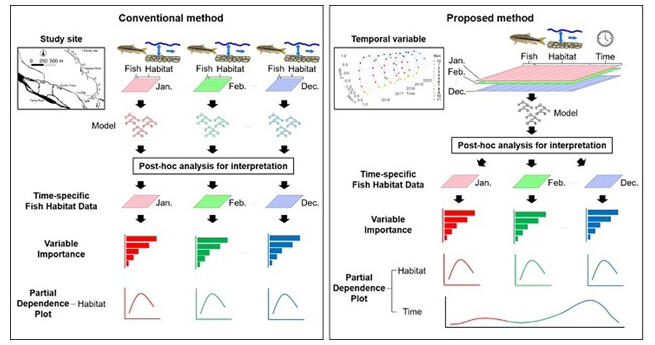Graduate Student Taichi Jibiki (currently at Pacific Consultants) of the Agricultural Engineering and Agro-Food Informatics Course, the Department of Agriculture at Tokyo University of Agriculture and Technology and Professor Shinji Fukuda of the Institute of Agriculture of the same university, announced that they have developed a species distribution model that can accurately predict the distribution of the Japanese river crucian carp "Kawamutsu," an alien freshwater fish species in Japan. Based on 5 years of monthly survey data from the Yagawa River, an urban spring-fed river in Tachikawa and Kunitachi Cities, Tokyo Prefecture, the Kawamutsu occurrence data and physical environment data were analyzed using machine learning. The results are expected to be useful in developing ecosystem management and conservation strategies and were published in the international academic journal iScience on March 6.

Conventional methods consider temporal information by dividing the data into time periods of interest and constructing models for each period of interest. The proposed method considers temporal information by inputting a variable that indicates temporal distances. In the conventional species distribution model, variable importance and partial dependence plot for a specific period were assessed by applying the model built using the training data to the post hoc test data. In the proposed method, variable importance and partial dependence plot for a specific period were computed by applying the model built using the entire training dataset to the post hoc test data in a specific period. Compared to the conventional methods, the proposed method does not lose the temporal continuity of the distribution data of the target species and physical habitat data; thus, it is possible to discuss the results based on their temporal continuity. Since the proposed method inputs time-related variables as continuous variables, it is possible to calculate variable importance and partial dependence plot for the time-related variables.
Provided by TUAT
Freshwater ecosystems are among the most biodiverse on earth, but they are also threatened by various factors. The accurate prediction of the spatial distribution of alien species and their dynamics is extremely important for ecosystem conservation, especially because alien species have a large potential impact on them. However, the conventional species distribution model subdivides data by period when considering temporal variation in the behavior of target organisms. The problem with the conventional model is a low prediction accuracy for data from different periods.
This study used random forests, a typical machine learning algorithm, and successfully captured the temporal continuity of species' spatial distribution by introducing time variables. The algorithm combines decision trees and bagging methods for classification, regression, and clustering. It provides a detailed understanding of the target species' ecology and response to the environment from a temporal perspective, with prediction accuracy that exceeds that of conventional models.
The group analyzed the relationship between the occurrence data of Kawamutsu and physical environment data for 5 years of monthly survey data from the Yagawa River using random forests. In addition, temporal variables were incorporated to derive temporal transitions in the ecology and environmental response of the target species. The method is reportedly not limited to predicting the distribution of the Kawamutsu. However, it can provide quantitative information that contributes to establishing specific strategies and goals for maintaining the health of aquatic ecosystems by integrating models for multiple species.
Fukuda said, "The results of this research were obtained by analyzing a species distribution model that introduced a time variable proposed by a student (at the time of the study) using field survey data accumulated by members of the Laboratory of Water Resources Planning, Faculty of Agriculture at the Tokyo University of Agriculture and Technology. We plan to use this species distribution model to quantitatively assess the ecological characteristics of the target organisms, such as habitat and behavior, so that our research can contribute to formulating sustainable environmental management strategies."
Journal Information
Publication: iScience
Title: Temporal variables improve a spatiotemporal species distribution model for the non-native freshwater fish Candidia temminckii
DOI: 10.1016/j.isci.2024.109445
This article has been translated by JST with permission from The Science News Ltd. (https://sci-news.co.jp/). Unauthorized reproduction of the article and photographs is prohibited.




